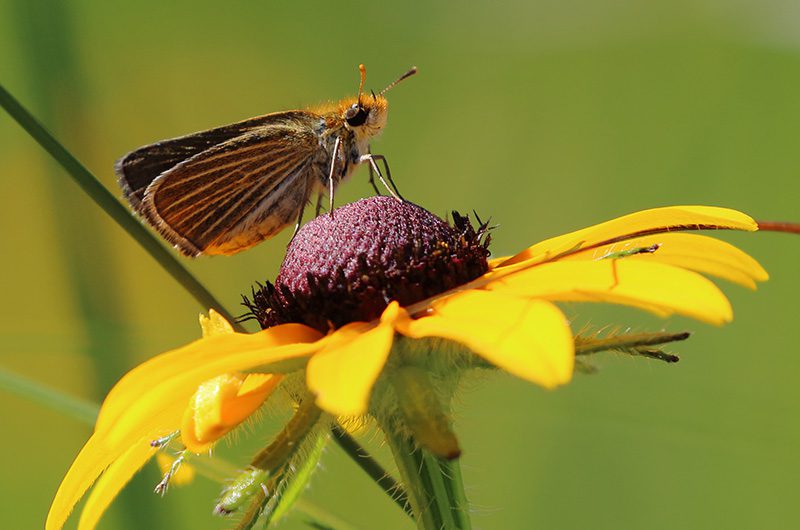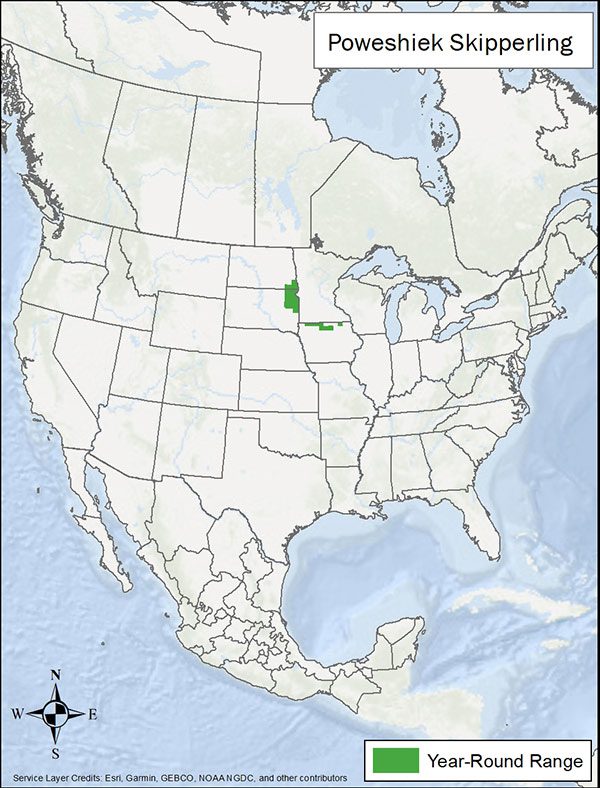LandPKS Learning
Habitat Hub

Poweshiek Skipperling
Poweshiek skipperling butterfly populations have shown a well-documented collapse in less than a decade between 2000 and 2010, with likely extirpation of over 95% of the populations. In 2000, Poweshiek skipperling was known from native prairie remnants in Iowa, Minnesota, North and South Dakota, and Wisconsin and in fens in Michigan. By 2010, it was no longer found in the Dakotas, Minnesota, and Iowa. The original core habitat range for the species was orders of magnitude larger than the current range. The cause of this wide-spread decline is still unknown.
Oarisma poweshiek
Identification
Poweshiek skipperlings are small dark grayish-brown butterflies with a purplish tone. They have orange on leading edges of the forewing and occasionally the base of the hindwings. The undersurface of the hindwing has prominent white or sometimes orange veins, outlined in white on a pale brown surface with black on the inner margin. The Poweshiek skipperling is listed as Endangered in the United States and Endangered in Canada.
Observation Tips
Poweshiek skipperlings were once widespread in the Upper Midwest and are currently known from Wisconsin, Michigan and Manitoba. The Canadian population is 621 mi/1000 km from the populations in the United States. While most of the US populations are on private lands, most of the Canadian occupied habitat is on protected lands with appropriate management. Poweshiek skipperling larvae hibernate, with adults flying in late June and July.
Interesting Fact
Poweshiek skipperling butterfly populations have shown a well-documented collapse in less than a decade between 2000 and 2010, with likely extirpation of over 95% of the populations. In 2000, Poweshiek skipperling was known from native prairie remnants in Iowa, Minnesota, North and South Dakota, and Wisconsin and in fens in Michigan. By 2010, it was no longer found in the Dakotas, Minnesota, and Iowa. In fact, the best populations surveyed in 2000 were completely gone in 2010, and significant declines were seen in the other populations of Poweshiek skipperlings. The original core habitat range for the species was orders of magnitude larger than the current range. The cause of this wide-spread decline is still unknown.
Ideal Habitat
Ideal habitat for Poweshiek skipperlings is remnant prairie areas including virgin tallgrass prairie, prairie fens, moist meadows, cinquefoil seeps, sedge meadows, and historically grassy lakeshores and stream margins, especially in Michigan and Indiana. Fens are wetlands fed by groundwater which provides unusual water chemistry, therefore unusual plants, and animals.
Larvae use several species of grass and sedge. Major known larvae foodplants include prairie dropseed (Sporobolus heterolepis), little bluestem (Schizachyrium scoparium), and spike rush (Rhynchospora). Larvae overwinter above ground on grass or sedge leaf blades or stems.
Adult skipperlings take nectar from many different flowers, including black-eyed Susan (Rudbeckia sp.), purple coneflower (Echinacea pallida), and coneflower (Ratibida sp.). Eggs are laid near the tips of grass blades.

Range map provided by United States Fish and Wildlife Service and does not show range within Canada and small occurrences in Michigan, Wisconsin, and Minnesota are hard to see on this map.
Management Activities that Benefit Species – Best Management Practices (BMPs)
Maintain intact tallgrass prairie, mixed and tallgrass prairie fens, and surrounding areas. If prescribed burning is conducted, maintain unburned refugia and several years between fires for the majority of any habitat patch. Mechanical removal of woody plants found within these prairie habitats may be a better option than burning. Poweshiek skipperlings are more sensitive to fire than many skippers. Buckthorn and black swallow-wort or dog strangle vine are invasive species that will dominate roadsides, disturbed areas, old fields, gardens, fens, and other wetlands. If this weed is known from the area, a multiyear integrated control effort should be undertaken. Plant native nectar plants on your land. Allow augmentation of existing populations, translocation, and reintroduction of Poweshiek skipperlings onto your land.
Management Activities to Avoid
Avoid destruction of prairie fens and surrounding native prairies through conversion to croplands or sub development. Avoid woody encroachment into native prairie habitats. Avoid haying in June and July when skipperlings are flying and laying eggs. Avoid herbicide and pesticide application in or near occupied habitat.
Other Species that Benefit from Similar Habitat Management
MManagement of Poweshiek skipperling will benefit monarch butterflies, eastern massasauga, and other tallgrass prairie butterflies.
Download
Download the Poweshiek Skipperling fact sheet
Other Resources
NatureServe. 2021. NatureServe Explorer: An online encyclopedia of life [web application]. Version 7.1. NatureServe, Arlington, Virginia Poweshiek skipperling
USFWS. 2022. Recovery Plan for Poweshiek skipperling (Oarisma poweshiek).
USFWS. 2019. 5 year Review Status Assessment. Poweshiek Skipperling
Mobile App | Data Portal | Knowledge Hub | Habitat Hub | Learning Collections | Blog | About | Contact | Support



